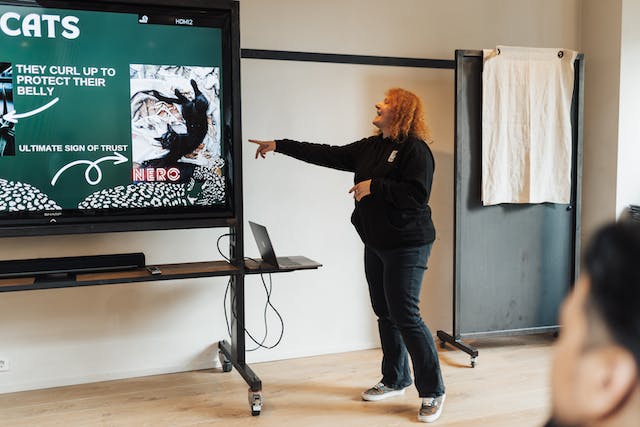Imagine standing before a sea of faces, all eyes fixed on you, their minds hanging on your every word. You feel a surge of adrenaline, a mix of excitement and nervousness. This is the power of public speaking – the ability to command attention, captivate an audience, and influence their thoughts and actions.
Persuasive public speaking is about more than just delivering a well-structured presentation. It’s about connecting with your audience on an emotional level, tapping into their hopes, fears, and aspirations. It’s about using the power of your words to inspire them to take action, to believe in your cause, and to embrace your message.
In today’s world, where information is abundant and attention spans are fleeting, the ability to speak persuasively is an invaluable asset. Whether you’re leading a team, pitching an idea to investors, or simply trying to make a difference in your community, the ability to deliver a compelling presentation can make all the difference.
In this article, we’ll explore the art and science of persuasive public speaking. We’ll uncover the secrets of crafting compelling narratives, mastering the mechanics of delivery, and overcoming public speaking anxiety. We’ll learn how to tailor our messages to specific audiences, craft powerful calls to action, and handle difficult questions with poise.
By the end of this article, you’ll have the tools and strategies you need to transform yourself into a persuasive speaker, capable of inspiring action, influencing decisions, and achieving your desired outcomes. So, let’s embark on this journey together and discover the power of persuasive public speaking.
Understanding Your Audience: The Foundation of Persuasive Speaking
Before you can craft a persuasive presentation, you must first understand your audience. Who are they? What are their needs, interests, and motivations? What are their expectations for your presentation? By taking the time to understand your audience, you can tailor your message to resonate with them on a deeper level.
Identifying Audience Needs, Interests, and Motivations
Your audience is not a monolith. They are individuals with unique perspectives, experiences, and aspirations. To effectively persuade them, you need to understand what drives them. What are their hopes, fears, and pain points? What are they looking for in your presentation?
Conducting audience research can help you gain valuable insights into your target audience. This could involve surveys, interviews, focus groups, or even simply observing their behaviour. By understanding their needs, interests, and motivations, you can craft a presentation that speaks to their hearts and minds.
Audience Segmentation Techniques for Targeted Presentations
Once you have a general understanding of your audience, you can further segment them into smaller groups based on shared characteristics. This could be based on demographics, interests, or even their level of expertise on the topic.
Audience segmentation allows you to tailor your message to each group more effectively. For instance, you might use different language and examples when speaking to a group of experts versus beginners. By understanding the unique needs and interests of each segment, you can create more targeted and impactful presentations.
Crafting a Compelling Narrative: The Art of Storytelling in Persuasive Presentations

Humans are wired for stories. We are naturally drawn to narratives that capture our imagination, evoke emotions, and connect with us on a personal level. In the world of persuasive public speaking, storytelling is a powerful tool that can transform your presentations from mere information dumps into captivating experiences.
The Power of Storytelling in Engaging Audiences
Storytelling allows you to connect with your audience on an emotional level, making your message more memorable and impactful. By weaving anecdotes, case studies, and real-life examples into your presentation, you can bring your message to life and make it resonate with your listeners.
Stories have the power to transport us to different worlds, introduce us to new perspectives, and evoke a range of emotions. When you use storytelling effectively, you can engage your audience’s minds and hearts, making them more receptive to your message.
Storytelling Techniques for Structuring Presentations]
A well-structured story can guide your audience through your presentation, making it easier for them to follow your train of thought and retain key information. Use narrative techniques such as the Hero’s Journey or the Problem-Solution-Outcome framework to create a compelling narrative arc.
Incorporate elements of suspense, conflict, and resolution to keep your audience engaged and invested in the story. Use vivid descriptions and sensory details to paint a picture in their minds and make your story come alive.
Using Anecdotes, Case Studies, and Real-Life Examples
Anecdotes, case studies, and real-life examples are powerful storytelling tools that can add credibility and relatability to your presentations. These stories illustrate your points in a memorable way and make them more tangible for your audience.
When selecting anecdotes and case studies, choose those that are relevant to your audience and resonate with their experiences. Ensure that the examples you share support your overall message and contribute to the persuasiveness of your presentation.
Check my first Toastmasters Icebreaker speech to understand how to use real-life experience to craft your speech or presentation.
Mastering the Mechanics of Delivery: Vocal Projection, Body Language, and Visual Aids

The way you deliver your presentation can make all the difference in its impact. Vocal projection, body language, and the use of visual aids are all essential elements of effective public speaking. By mastering these mechanics of delivery, you can captivate your audience, enhance your credibility, and ensure that your message is received loud and clear.
The Significance of Vocal Projection and Modulation
Vocal projection is the ability to project your voice to the back of the room without shouting. It’s about using your diaphragm to support your voice and using clear articulation to make sure your words are understood.
Modulation is the variation of your pitch, volume, and pace. It’s about using your voice to add emphasis, create interest, and avoid a monotone delivery. By modulating your voice effectively, you can keep your audience engaged and make your message more impactful.
The Impact of Body Language on Audience Perception and Engagement
Body language is a powerful form of nonverbal communication. It can convey confidence, enthusiasm, and credibility, or it can make you appear nervous, disengaged, or untrustworthy.
Pay attention to your posture, facial expressions, and hand gestures. Make eye contact with your audience, stand up straight, and smile. Use gestures to emphasize your points and avoid fidgeting or crossing your arms.
Effective Techniques for Using Visual Aids
Visual aids, such as slides, images, and videos, can enhance your presentation and make it more memorable for your audience. However, it’s important to use them wisely and avoid overloading your audience with too much information.
Use visuals that are clear, concise, and relevant to your message. Keep your slides simple and easy to read, and use high-quality images and videos. Practice using your visuals in advance so that you can transition smoothly between them.
Overcoming Public Speaking Anxiety: Strategies for Confidence and Poise

Public speaking anxiety is a common fear that affects many people. It can manifest as a variety of symptoms, such as nervousness, sweating, trembling, and a racing heart. While public speaking anxiety can be debilitating, there are effective strategies you can use to manage it and deliver a confident and poised presentation.
The Prevalence of Public Speaking Anxiety and Its Impact on Presentation Effectiveness
Public speaking anxiety is estimated to affect up to 75% of the population. It can have a significant impact on presentation effectiveness, causing speakers to appear nervous, disengaged, and less credible.
Public speaking anxiety can also lead to self-fulfilling prophecies. When speakers are anxious, they are more likely to make mistakes, forget their lines, and come across as unprofessional. This can further fuel their anxiety and make it more difficult to deliver an effective presentation.
Strategies for Managing Public Speaking Anxiety: Relaxation Techniques, Positive Self-Talk, and Visualization
There are a number of relaxation techniques that can help to reduce public speaking anxiety, such as deep breathing exercises, progressive muscle relaxation, and mindfulness meditation. These techniques can help to calm your mind and body, making it easier to focus on your presentation.
Positive self-talk is another powerful tool for managing public speaking anxiety. Instead of focusing on negative thoughts, practice replacing them with positive affirmations. Remind yourself of your strengths and accomplishments, and visualize yourself delivering a successful presentation.
The Importance of Preparation and Practice in Building Confidence and Reducing Stage Fright
One of the best ways to overcome public speaking anxiety is to be well-prepared. The more you know about your topic, the more confident you will feel when you deliver your presentation. Practice your presentation in advance, and be prepared to answer questions from your audience.
Visualization can also help to reduce stage fright. Imagine yourself delivering a successful presentation. See yourself speaking clearly and confidently, and envision your audience engaged and receptive to your message. This can help boost your confidence and reduce your anxiety.
Check this article to get a better understanding of the fear of public speaking.
The Call to Action: Inspiring Action and Influence

The ultimate goal of any persuasive presentation is to inspire action. You want your audience to leave your presentation feeling motivated and empowered to take action on your message. A strong call to action (CTA) is essential for achieving this outcome.
The Importance of a Clear Call to Action in Persuasive Presentations
A clear and compelling CTA tells your audience exactly what you want them to do after your presentation. It should be specific, measurable, achievable, relevant, and time-bound (SMART).
Your CTA should be integrated throughout your presentation, not just an afterthought at the end. Build up to the CTA by highlighting the benefits of taking action and addressing any potential objections.
Strategies for Crafting a Compelling Call to Action that Resonates with the Audience and Motivates them to Take Action
Use strong verbs that inspire action, such as “learn,” “discover,” or “join.” Make your CTA specific and actionable, such as “sign up for our newsletter” or “visit our website.”
Create a sense of urgency by using phrases like “limited-time offer” or “don’t miss out.” Provide clear instructions on how to take action, such as “visit our website at [website address]” or “call us at [phone number].”
Techniques for Handling Questions and Objections Effectively
Anticipate potential questions and objections from your audience and prepare well-thought-out responses. Practice answering these questions confidently and professionally.
Listen attentively to questions and objections, and address them directly and respectfully. Acknowledge the validity of concerns, and provide clear and concise explanations. Use positive language and avoid getting defensive.
Final Thoughts
As you embark on your journey to become a persuasive public speaker, remember that the true power of this skill lies in its ability to connect with others, inspire action, and make a positive impact on the world. By understanding your audience, crafting compelling narratives, mastering the mechanics of delivery, overcoming public speaking anxiety, and delivering a powerful call to action, you can transform your presentations into catalysts for change.
Embrace the art of storytelling, for it is the language that resonates with the human spirit. Utilize vocal projection and body language to captivate your audience and convey confidence. Employ visual aids effectively to enhance your message and make it more memorable.
Approach public speaking not with fear but with excitement, for it is an opportunity to share your knowledge, inspire others, and shape perceptions. Remember, the most persuasive speakers are not those who simply deliver information, but those who connect with their audience on a deeper level, evoking emotions and leaving a lasting impression.
So, go forth and embrace the power of persuasive public speaking. Let your voice be heard, your message resonate, and your influence inspire others to make a difference. The world awaits the impact you can make through the art of persuasive communication.

